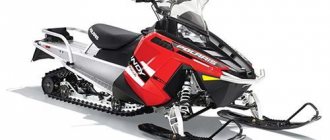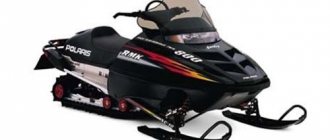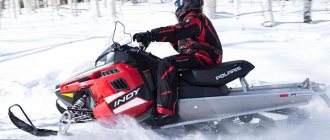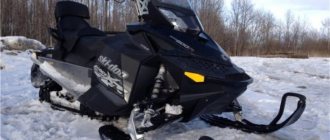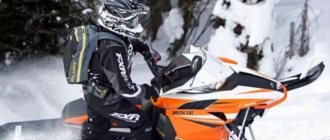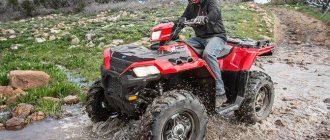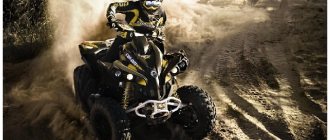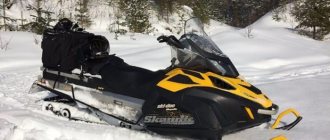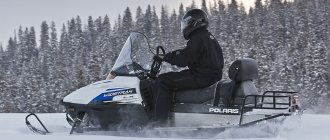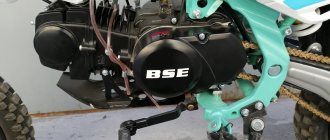One of my friends, having listened to smart people, waited for the snow to melt and prices to fall, and received the dream of his life for ridiculous money. I won’t discuss the make and model, I’ll just say that it (the snowmobile, not the one I know) was produced in 1995. And so a new season began, and with it came old problems. The device is quite a few years old, you can’t fix everything yourself - instead of riding, you’ll have to become a “golden hands” mechanic and fix, fix, fix... However, nothing particularly serious was broken in my friend’s snowmobile, it was just the enviable constancy with which troubles came out that spoiled the mood out. It was decided to change the device.
REVERSE QUESTIONS This is where the question arose of how to choose the right snowmobile for your budget. First, it is important to understand for what purpose it is needed. In our case, ride without extreme sports (not enough experience, and not necessary at this stage) with a companion or children. The second defining point that many people forget is the cost of operation. That is, fuel consumption, the cost of consumables (prices for different brands vary quite significantly) - primarily belts. And the third, but important factor is how much money you have for this pleasure. In this case, as you remember, we took 250 thousand rubles as a reasonable limit. and began searching for actual snowmobiles to buy.
Regarding the first point - purpose - tourist models are best suited; they are as comfortable as possible for both the driver and the passenger, as a rule, they have heated handles, a comfortable, albeit small, trunk and rear-view mirrors, which is especially important when driving in a group. But there are also disadvantages: in deep snow, only an experienced driver can confidently operate such equipment. In addition, when moving in reverse, such snowmobiles often bury themselves - simply due to the design of the rear suspension.
Utilitarian models can also be considered as an option, but they are more difficult. This technique is often specific and mainly designed for moving from point A to point B. The same set of options as touring cars, almost the same engines, but much worse handling (increased turning radius due to a wider track and significantly large mass). But lower specific pressure on snow is not true for all models, but for many. But in reverse they are much better, the rear suspension breaks and the snowmobile does not bury itself, this is a big plus for beginners. And there are much more luggage compartments here.
As for the engine, based on operating costs and budget, you will have to focus on two-stroke engines with a displacement of no more than 600 cubic meters.
AND STILL A “TOURIST” So, taking into account that handling plays a serious role, we focus on the “tourist”. Further more. Based on all of the above, we recruit candidates. Note that sellers, as a rule, overestimate the year of manufacture, and therefore it is necessary to compare the model range with the model being sold. Our list includes the 2005 Polaris Trail Touring 550 DLX. , Yamaha Venture 500 XLF 2004, BRP GSX 550 F 2006. and Arctic Cat Panther 570 LX 2005. All these cars are 6–8 years old, all have air-cooled engines with an electric starter and have proven themselves quite well. In terms of “horses” the differences are not significant, but in terms of suspensions they are.
WITHOUT EXTRA IRON The Polaris Trail Touring 550 DLX has been in production for a long time, so it looks a little archaic. The model is well-designed and reliable, the reverse gear is electric PERC (the motor simply restarts in the opposite direction, and there is no bulky hardware - the reverse box - no extra weight). It should be noted that this system only works if the engine is in good condition, otherwise the snowmobile simply stalls when the reverse is turned on. The front trailing arm suspension is reliable, but it is not the most comfortable, and the rear suspension is also not distinguished by outstanding characteristics. The passenger seat is removable, which increases the size of the trunk. The main consumables are variator belts, they cost from 2000 rubles. for non-original up to 4500 for “original”.
JAPAN - HARDER The Yamaha Venture 500 XLF, announced as a 2004 model, upon closer examination turned out to be older - 2001. Its reverse gear is implemented through a reverse gearbox - very reliable and rarely causing any complaints. The suspensions are almost identical to Polaris, only they have less travel and are stiffer, but the handling is on par. Belts – from 2500 rub. for the original. Non-original from 2000 rub.
THE MAIN THING IS THE DESIGN The BRP GSX 550 F compares favorably with the other “oldies” with its new design. The reverse here is electric (like Polaris, but it works more adequately). The suspensions are the most comfortable, and the passenger seat and handles are the best you can imagine; here BRP, as usual, is at its best. All BRPs are equipped with a chip key, which, of course, is a plus in terms of theft, but there is also a minus. If you lose your key or it malfunctions, you can only solve the problem through a dealer, and this is not a cheap pleasure. CVT belts – from RUB 3,000. for the original, non-original - from 2000.
Engine characteristics
| Engine model | Polaris® |
| Engine Configuration | Row |
| Number of cylinders | 2 |
| Engine cycle | 2 stroke |
| Horsepower (bhp/kW) | 60 / 44.8 |
| Cooling system | Air/Fan |
| Valve configuration | Reed Valve |
| Cylinder diameter (millimeters/inches) | 73 / 2.88 |
| Piston stroke (mm/inches) | 65 / 2.56 |
| Engine displacement (cubic centimeters/cubic inches) | 544 / 33.2 |
| Starter type | Electric |
| Fuel requirements | Standard |
| Fuel type | Gasoline / Injection |
| Turbocharging | — |
| Supercharger | — |
| Carburetor model | Mikuni |
| Injector | — |
| Carburetor | + |
| Number of carburetors | 2 |
| Carburetor Size (mm) | 34 |
| Injection type | Carburetor |
| Emergency switch | Standard |
Engine
The machine is equipped with a gasoline engine of its own production. Polaris engineers designed a motor that matches the other parameters of the snowmobile. The result is an ideal balance between dynamics, efficiency and reliability. The two-cylinder layout with a displacement of 0.5 liters had a favorable effect on the weight of the structure - in the sense that the 550 IQ LXT 2013 snowmobile has a low weight and excellent maneuverability. The cylinder diameter and piston stroke are 73 and 65 mm, respectively, and the power of the power plant reaches 60 horsepower. Ignition is electronic type (CDI). The fuel system is two-carburetor (brand VM34). This system has proven itself worthy in difficult climatic loads, as well as with high load capacity. The air cooling system, in turn, is designed to prevent overheating of the engine in the warm season.
Suspension
| Front suspension type | Independent Trailing Arm |
| Front suspension travel (inches, millimeters) | 10 / 254 |
| Front suspension model | IQ |
| Front stabilizer | — |
| Shock absorber type | Adjustable shock absorber |
| Rear suspension travel (inches, millimeters) | 14 / 356 |
| Rear shock absorbers | 2 |
| Rear suspension model | IQ |
| Rear anti-roll bar | — |
| Front shock absorber model | Ryde FX® |
| Front shock absorber type | Adjustable Gas Shock |
| Coilover | + |
| Rear shock absorber model | Ryde FX® |
| Rear shock absorber type | Gas Shock |
| Central shock absorber model | Ryde FX® |
| Type of central shock absorber | Adjustable Gas Shock |
2021 Polaris 550 Indy LTX Snowmobile Review
Polaris 550 Indy LTX - a budget two-seat touring snowmobile
When it comes to marketing niches, one notable example is how Polaris is using the Indy series to differentiate its line of utilitarian outdoor sleds. Check out the 2021 Indy family. The ubiquitous 550cc air-cooled twin-cylinder engine is used to spin the 144-inch track in the three single-seat sleds. But there's also a utilitarian, sporty outdoor model with a 144-inch track—the 2021 Polaris 550 Indy LTX. This is one of the options for a budget double touring snowmobile.
Snowmobile Polaris 550 Indy LTX
Not everything is new for 2021, the Polaris 550 Indy LTX shares several engineering features with other 144-inch track models in the Indy lineup, but there are niche differences that justify the price differences. The base 144-inch Indy is the sportiest model, designed for riding on groomed trails. The utilitarian off-road model 550 Indy Voyageur is somewhat more expensive, equipped with Gripper skis that are located closer to each other. The two-seat 550 Indy LTX comes in two versions: White Lighting and the more stylish Turbo Silver. They differ only in color and set of stickers.
In addition, the Voyageur and base 550 Indy 144 are designed for one person, while the LTX is designed entirely for two travelers. The LTX is highly likely to be found among other snowmobiles at rental stores. This model is relatively inexpensive and features proven components such as the 550cc Fuji twin-cylinder engine and PowerBloc drive system.
What makes the Polaris 550 Indy LTX snowmobile suitable for rental shops also makes it suitable for touring. Comfort for two passengers is ensured by the larger rear suspension, which has 358 mm of vertical travel and is controlled by RydeFX MPV shock absorbers. You can also rest assured that Polaris engineers have worked hard to tune the suspension to be stiff enough to support two passengers. The LTX will also ride great on groomed trails and handle superbly on tight trails, thanks to its wide 1079mm ski clearance and Pro-Steer skis themselves.
The front suspension travels a comfortable 180 mm, which is also controlled by RydeFX MPV shock absorbers. The front shock absorbers are equipped with coilovers. Both the front and rear suspensions can be adjusted to suit different snow conditions.
Because the 550 Indy LTX should be used primarily on groomed trails, Polaris engineers installed an Energy track that measures 15 inches wide by 144 inches long with one-inch lug height. Voyageur and Indy 144 models feature a more aggressive Cobra track design with 1.35-inch lugs for better off-road traction.
Polaris engineers also prepared the LTX for long journeys with a 43.5-liter fuel tank and various passenger amenities. The seat is spacious enough for two, it is equipped with a comfortable fixed backrest, easily accessible handles for the passenger, although not heated.
The rear parcel shelf will hold your gear, and you can use a wide range of luggage bags. LTX, built on the Pro-Ride platform, resulting in a sled with a forward-facing riding position. As for the passenger seat, it is slightly raised to give the passenger a better view. Even the larger Pro-Ride platform is said to be 34kg lighter than previous Polaris two-seat models.
The driver will highly appreciate the updated one-piece handlebar of the Polaris 550 Indy LTX snowmobile. The steering column angle has been changed to 15 degrees to make it more comfortable for the driver with a passenger behind him. Pro-Steer skis make the snowmobile easier to turn into turns than the previous version, and their flexibility provides better traction.
The reliable Fuji two-cylinder engine is one of the key features of the snowmobile, which ensures low cost. This epic two-stroke from Polaris produces 55 horsepower and uses traditional 34mm Mikuni carburetors with a dash-mounted fuel enrichment lever. The twin-cylinder 550cc engine has a reputation for being easy to start, with an electric starter included as standard. Polaris' push-button reverse has also proven to be reliable over time. Paired with the PowerBloc drive system, the engine has good torque in the low rpm range, allowing the sled to pull away easily and easily accelerate to highway speeds. Power in the mid-range is very satisfying, but from here this two-cylinder two-stroke is slow to spool up to top revs, which will be enough for you to get into most trail systems.
Once you're out on the trail, you'll appreciate how Polaris designers have worked on the ergonomics of the riding position to keep you comfortable. The tall windshield has wings to protect your hands and deflect cold winds. The only thing we were worried about was that such a large windshield might warp. The Polaris windshield generally provides very good visibility and protection.
When you travel alone, the passenger handles can get in the way. Admittedly, though, the LTX's rear grab handles aren't as intrusive as the 550 Indy Adventure's removable passenger grab handles. Some other two-person sleds have an adjustable backrest, but the Polaris LTX has a fixed backrest. It cannot be moved forward when you are driving alone. A small problem, but it’s nice when you can “tailor” the snowmobile to suit you.
When it comes to passenger comfort, the Polaris 550 Indy LTX has raised footpegs, a softer backrest, and plenty of room around the grab handles.
Like other long-track 550 Indy models, the LTX features a double A-arm front suspension, a robust rear suspension with more than a foot of vertical travel, and a 144-inch track that minimizes road shake. A sporty front bumper, side mirrors and overall nice exterior help the Indy LTX look stylish in any color scheme. If you want to customize your LTX with additional equipment, Polaris dealers will be happy to help. But even in its base configuration, the 550 Indy LTX is a great budget touring snowmobile.
Specifications Polaris 550 Indy LTX
- Engine: Polaris/Fuji two-cylinder, two-stroke, 544 cm3, air-cooled, two Mikuni VM34 carburetors, digital capacitor ignition, exhaust system with filter
- Power: more than 50 hp
- Drive: CVTech PowerBloc 50 drive clutch, Invance driven clutch
- Front Suspension: Polaris Pro-Ride, 180mm max vertical travel, RydeFX MPV coil-over shocks, Polaris Pro-Steer skis
- Rear Suspension: Polaris Indy, slide rails, RydeFX MPV shocks, 358mm maximum vertical travel
- Length: 3150 mm
- Width: 1219 mm
- Height: 1371 mm
- Distance between skis: 1079 mm
- Track: 15" x 144" x 1" Energy
- Brake system: hydraulic Polaris RMK
- Weight: 212 kg (claimed)
- Fuel tank capacity: 43.5 liters
- Equipment: Standard: Pro-Steer skis, fixed-back 2-up seat, 89mm fixed platform, electric start, push-button electronic reverse, one-piece one-piece steering wheel, digital multifunction display, analog speedometer, tall, clear windshield
- Extras: 12V socket, additional cargo accessories, various windshields
Specifications
| Footage) | 10 |
| Overall Width (inches/mm) | 48 / 1220 |
| Overall Height (inches/mm) | 48.5 / 1230 |
| Maximum ski base length (inches/millimeters) | 42.5 / 1080 |
| Minimum ski base length (inches/millimeters) | 42.5 / 1080 |
| Length (foot/foot) | 10 |
| Length (foot/inches) | 0 |
| Snowmobile Dry Weight (lbs/kg) | 544 / 247 |
| Fuel tank capacity (gallons/liters) | 11.5 / 43.5 |
| Engine displacement to weight | 1 |
Tested by an amateur
Text: Leonid MindelPhoto: Igor Georgievsky
Testing snowmobiles is a new thing for us and, to put it mildly, unusual. But when have we given in to difficulties?! The cars taken for the test were Sport Touring 550 and Widetrak LX from the famous American company Polaris. But once the problem of choosing models was solved, we were faced with a new one - how exactly to test. Agree, the established technology for testing cars is completely unsuitable here. We decided to carry out reconnaissance (read testing) in force. So what's the end result? As a result, I went on a multi-day snowmobile trip across Karelia... For four days, through light and darkness, along compacted roads, on the ice of rivers and lakes, through forest snowdrifts, we stubbornly moved forward on four ski-tracked vehicles. And all four days I compared, analyzed and thus... had a wonderful time.
Externally, the models are very similar. But this is only at first glance. In fact, the Sport Touring 550 is a touring machine with a fairly powerful (550cc) two-stroke air-cooled engine, a narrow track and a standard set of options. In general, a light and dynamic car. But Widetrak LX is a completely different class of device. Firstly, it is more massive (one and a half times heavier than the Touring), and its two-stroke engine with a slightly smaller volume (500 cc) is water-cooled and has the ability to spin a wide track through a low gear. It would seem, how can one compare models with such different characteristics? Yes, snowmobiles are very different from each other technically, but they have one thing in common - both “snowmobiles” are designed for travel.
Any roadway (asphalt, crushed stone, sand) acquires an additional stable coating in winter. This is snow, rolled to a smooth surface and slippery like ice. So, on this improvised skating rink, the snowmobile feels like a fish in water. Here he is able to maintain the highest possible speed. But you shouldn’t get carried away - when you sharply turn the steering wheel or brake, the snowmobile becomes practically uncontrollable.
Sport Touring 550. Very sensitive to steering movements, easily goes into a skid, however, it is just as easy to “pull out” from this same skid. Due to its light weight, the snowmobile has to tilt its body when turning (at speeds above 40 km/h). Having gotten used to it a little, I found it more convenient to take turns in a controlled drift. Drive in its purest form! Comfortable travel speed is 80–100 km/h. No, really, 60 is boring, and 110 is scary...
In general, driving on the roads was a lot of fun on both models, although from time to time I had to drive onto the snowy side of the road to cool the ski runners - they overheat from a long ride on a hard surface. On the Widetrak, it was necessary to drive into the snow even more often, and on the “hunting” model, in addition to the runners, it was necessary to cool the engine radiators, designed to withstand the ingress of loose snow.
Our vast Motherland is in no way deprived of snow. I will say more, in our country it is customary to measure even the thickness of the snow cover not in centimeters. Knee-deep, waist-deep, chest-deep - these are Russian standards. And the snowmobile, although it was created for snow, is oh so reluctant to ride on loose virgin soil.
Widetrak LX. By shifting into a lower gear, I avoided all the launch problems, and the wide track easily kept the snowmobile afloat. The car went 40 on virgin soil, and it was felt that this was far from the limit. As a result, having ridden the “tractor”, there was, frankly speaking, a reluctance to continue the journey through the loose snow in the Touring.
Lake. Thick ice is covered with snow unevenly - sometimes half a meter high, sometimes a smooth surface of snow crust, or even completely bare ice...
Widetrak LX. But on the heavy LX I didn’t get any pleasure from jumping; on the contrary, after each flight I felt like I was falling like a sack of flour. The wide track made it much more difficult to catch the car. 60–70 km/h was the speed at which I felt more or less calm. But on bare ice the snowmobile walked completely smoothly.
But since we are testing snowmobiles as touring ones, the actual load capacity of the vehicles plays an important role. Both cars are two-seaters, there are luggage compartments, tow hooks too...
Widetrak LX. This is where a predictable, but still unexpected surprise awaited me. Trak didn't react at all to the double load. Dynamics, handling and other characteristics remained unchanged (at least I didn’t notice a difference).
Of course, snowmobiles are very different from each other. Sport Touring is a car for adrenaline junkies. The speed is almost like that of a sports car, but at the same time there are two seats and a luggage compartment. But it’s better not to ride it in loose snow, it doesn’t like it. The Widetrak, on the other hand, is a workhorse. He doesn’t care about heavy loads or deep, loose snow. But you can’t expect any special athletic zeal from him (and he consumes much more gasoline). So what's the end result? Both cars have undoubted pros and cons. What did you want?
Don't chase the bells and whistles. Timofey Rogozhin, Director of the North-West Travel Agency (Petrozavodsk, Karelia)
Seats
| Number of seats | Solid |
| Seat adjustment | — |
| Material | Vinyl |
| Location | Driver and passenger |
| Folding seat | — |
| Number of seats | 2 |
| Back type | Removable |
| Backrest position | Passenger |
| Lumbar support adjustment | — |
| Grab Rail or Strap | Standard |
Video
The 550 IQ LXT is a superior snowmobile in terms of its towing capabilities, given its 500 kg payload capacity. In addition, there is also an additional trunk under the driver’s seat - you can store various items and accessories in it. Such practicality and spaciousness allows you to operate a snowmobile on the longest trips and expose it to the most dangerous difficulties. Therefore, the 550 IQ LXT model is in great demand among foresters and fishermen, for whom reliability, spaciousness and cross-country ability are among the priorities when buying a snowmobile.
Main features of the Polaris 550 IQ LXT snowmobile:
Appearance
| Frame material | Aluminum |
| Housing panel material | Plastic |
| Frame model | IQ |
| FloorBoard Location | Driver and passenger |
| Slip resistance | + |
| Snowboard mount for tunnel | — |
| Handles | Standard |
| Saddlebag protection | — |
| Belt protection | + |
| Hand Guards | — |
| Shield protection | — |
| LightGuard | — |
| Snow protection | + |
| Exterior Covers | Standard |
| Steering wheel | Standard |
| Front bumper | Standard |
| Rear bumper | Standard |
| Passenger Foot Rests | Standard |
| Ski material | Composite |
| Ski handles | Standard |
| Skag material | Carbide |
Snowmobile Polaris 550 IQ LXT
The Polaris 550 IQ LXT is a high-performance model that is the successor to the Polaris 600 IQ Widetrak snowmobile. Despite the change of generations, the device in question is still relevant today. The machine, which went into production in 2013, incorporated the best technical solutions at the time of launch. The model under consideration has undeniable advantages compared to its closest competitors of similar cost. This snowmobile has always been distinguished by good smoothness and cross-country ability. It has a balanced and durable design, as well as time-tested components and high maintainability.
The Polaris 550 IQ LXT snowmobile was developed by a well-known American company, which is one of the leaders in the production of such machines. Let us note the main features of the model - an advanced chassis, as well as sporty settings for the suspension and power plant. The technology amazes with its high-speed qualities, as well as smooth and fast acceleration, which is not accompanied by any twitching or jerking during gear shifting.
Particularly noteworthy is the modified power plant, which required modernization of the platform - it had to be adapted to more modern standards and norms in order for the car to remain relevant for several more years. Compared to classic utilitarian snowmobiles, the Polaris 550 model is more massive and adapted to high load capacity. Geometric cross-country ability has also increased. Moreover, the 550th model is no worse than the 600th Polaris and is adapted to driving on rolled snow, as well as deep snowdrifts. In this case, a powerful engine and wide tracks help out, making the 550th Polaris ideal for utilitarian purposes. The 550 IQ LXT snowmobile received a strong suspension with two A-arms, with the help of which it became possible to transport two people, as well as a load weighing 500 kg. At the same time, you can move on any roads, including icy surfaces. As for the driver's seat, it has been seriously modified for more comfortable control over long hours of driving. The backrest of the passenger and driver can be adjusted at your discretion. In addition, comfort and convenience are designed to enhance the functions of heated hand grips for the passenger and driver.
